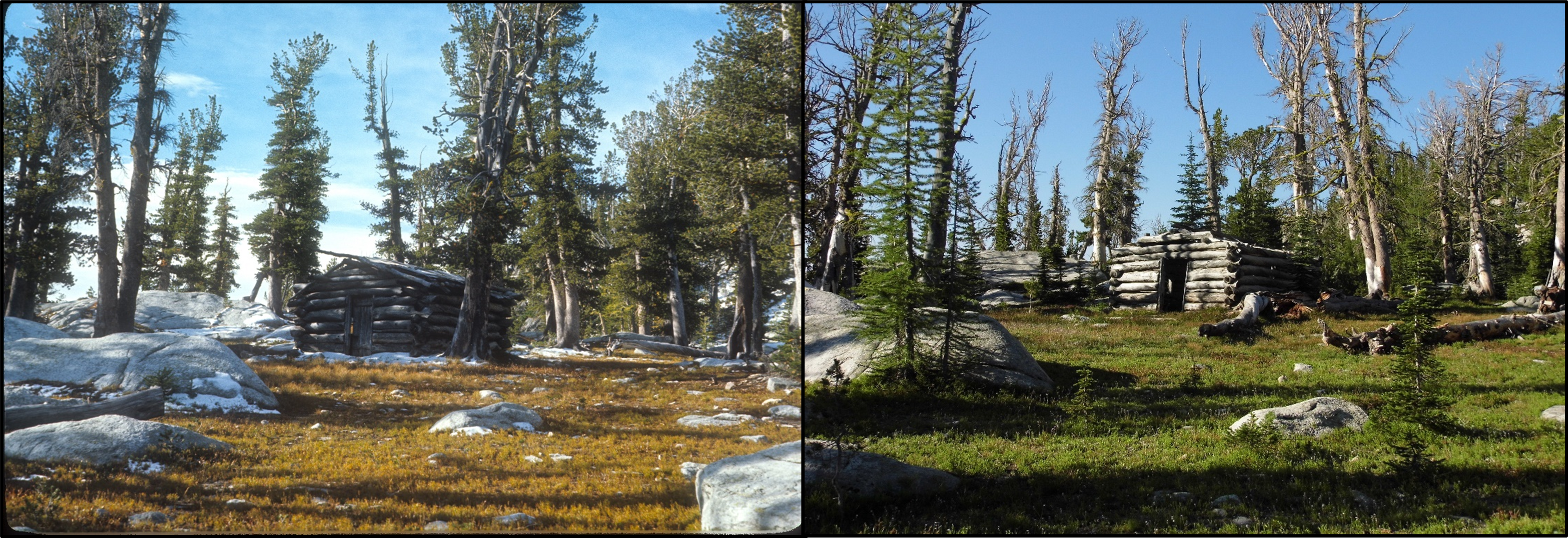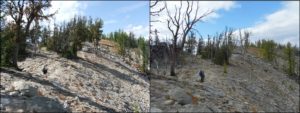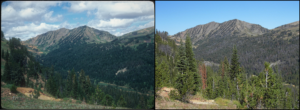
Repeat Photography Tells the Whitebark Pine Story
Repeat photography is a method for documenting landscape change by taking a series of photos from the same location over time. To track whitebark pine mortality, Jane and Garon Smith, along with Steve Arno, photographed three locations in western Montana.
Photo Series 1: Martin Lake Cabin
In the photo series above, Steve Arno took the photo on the left in 1971 at the Martin Lake Cabin in the Deer Lodge National Forest. The cabin was built from nearby whitebark pine and likely used to house workers when the lake’s outlet was altered for irrigation. Jane and Garon Smith photographed the cabin again in 2020 (photo on the right). This photo shows near-total mortality among the big, old whitebark pine that previously surrounded the cabin. Many trees have fallen, including a group of three that stood at the corner of the cabin (seen at the center of the photos). Few mature live whitebark pine are left, and most of the younger, smaller trees around the cabin are subalpine fir and alpine larch.
Photo Series 2: Glen Lake Peak

In the second photo series, the photo on the left was taken in 2005 at Glen Lake Peak in the Bitterroot National Forest. In 2005, there was already significant mature whitebark pine mortality, yet there were also many younger whitebark pine with abundant cones. When Jane and Garon visited in 2021, all the older whitebark pine were dead and many had fallen. Only a few younger whitebark pine are still alive. Alpine larches are now growing among the whitebark pine snags along the edge of the ridge that faces north-northeast.
Photo Series 3: Scotch Bonnet Mountain

These two photos were taken northeast of Cooke City, MT on the north-facing slope of Henderson Mountain in the Gallatin National Forest. In both photos, Scotch Bonnet Mountain is on the left with Lulu Pass visible in the upper left, and the western flanks of Sheep Mountain are on the right. Most of the forest in this valley is a mixture of whitebark pine, lodgepole pine, Douglas-fir, spruce, and subalpine fir. The photo on the left was taken in 1989 and shows some whitebark pine mortality on the slopes of Scotch Bonnet and Sheep Mountain. In the 2018 photo on the right, more whitebark pine mortality is visible. Loss of whitebark pine can be seen clearly along the left side of the right photo in the midground. Additionally, the foreground of the right photo shows increased forest cover and taller trees, including whitebark pines. Increased forest cover in 2018 is also visible along the edges of high-elevation openings across the valley. The north-facing slope of Henderson Mountain, where Jane and Garon were standing, is a meadow with scattered patches and ribbons of whitebark pines, both living and dead. When they were there in 2018, the ground under many of the living pines was littered with whitebark cobs and scales, and dozens of whitebark seedlings were emerging.
Future Repeat Photography Opportunities
While these photo series illustrate changes in whitebark pine mortality, Jane and Garon Smith recommend photographing whitebark pine regeneration, especially on sites with seedlings resistant to white pine blister rust. This could help justify the selection of some sites for whitebark restoration where previous photographs have documented high mortality. Thus, photo pairs that currently show only decline could be turned into trios and quartets that show promise for the future of whitebark pine and the organisms that depend upon it. For any questions, please contact Jane Smith at [email protected].
References Cited:
Smith, Jane Kapler; Smith, Garon C.; Arno, Stephen F. 2022. Repeat Photography Helps Tell the Story of Whitebark Pine. In: Foundation, Whitebark Pine Ecosystem, “Full Issue” (2022). H5II Conference. Research and Management of High-Elevation Five-Needle Pines in Western North America; October 5-7, 2021: 90-94. Available: https://digitalcommons.humboldt.edu/cgi/viewcontent.cgi?article=1013&context=h5ii.

